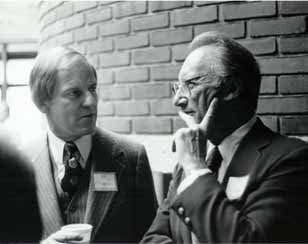
“Am I foremost a scientist or an engineer?” That was the question of the hour at Hopkins in the early 1960s, when an influential group of engineering faculty answered “scientist” and a faculty vote effectively made the School of Engineering disappear.
The beginning of the end came in 1961 when the school, founded in 1913, changed its name to the School of Engineering Sciences— “to insure that Hopkins will continue to produce engineers who are truly educated and creative individuals, not merely cogs in an increasingly complex industrial machine,” in the words of Hopkins President Milton S. Eisenhower.
“This was a period during which Americans’ attitudes toward science were changing. One result of Sputnik and the Cold War was that engineering as a discipline became less favored and the pendulum swung toward science,” observes the Whiting School’s Benjamin T. Rome Dean, Nick Jones. He notes that in 1961, Yale’s School of Engineering became the Department of Engineering and Applied Science within Yale College.
In 1966, the engineering school at Hopkins took an even bolder step and voted to merge the School of Engineering Sciences with the School of Philosophy to create a School of Arts and Sciences. The intent: a move away from the “practical” aspects of engineering instruction and toward the fundamentals of the field.
Although some had strong misgivings (particularly alumni), the arrangement appeared to work, at least initially. But by the mid-1970s, student enrollment in engineering courses began to wane at an alarming rate. The number of engineering faculty had dropped nearly in half, down to 44 at one point. Many believed that engineering had lost its way.
In reaction to the growing expressions of unease, in 1976 then university President Steven Muller appointed eight engineers and scientists to a blue-ribbon committee on engineering. The committee agreed that Johns Hopkins needed to re-establish a separate school of engineering.
George Owen, dean of the School of Arts Sciences and a nuclear physicist with a degree in mechanical engineering, argued that engineering needed its own home. “Engineers, like a technological age, and the university must be involved with the present.”
The university trustees established an ad hoc committee to address funding issues and the new school’s organization. Willard Hackerman ’38, a trustee and president of the Whiting-Turner Contracting Company, chaired the committee, which also included trustees Herschel L. Seder ’39 and F. Pierce Linaweaver ’55, ’65 PhD.
Charles R. Westgate, a professor of electrical engineering who chaired the faculty commit- tee for the school’s re-establishment, says that nearly all of the momentum originated with the trustees. “Willard Hackerman in particular had a very big influence. He was concerned, like others were, about the drop in enrollment and the [faculty] layoffs,” says Westgate, now a professor emeritus in the Department of Electrical and Computer Engineering. “He thought that engineering here had become quite vulnerable.” Hackerman helped secure a gift from the estate of George William Carlyle Whiting, co-founder of Whiting-Turner, which made the new school a reality and the board voted approval of its reestablishment in spring 1978. In the search for the inaugural dean, Muller looked inward and tapped David VandeLinde, an energetic young professor of electrical engineering.
VandeLinde, only 35 at the time, says that Muller told him he wanted a school that would be “uniquely Hopkins.” VandeLinde likes to joke that he started with just an office, a filing cabinet, and a secretary. Clearly, he had a formidable task ahead: Recruit new faculty, reorganize and ries, and do this all in less than six months. “We didn’t have a lot of money, but being at a world-class university made a lot of things possible. A lot of academics were excited about the prospect of being part of an engineering school here,” says VandeLinde. “We would not have been able to build this new school so well and so fast if we had not been at a place like Johns Hopkins.”
The school was to be small, but of high quality, attracting top students and achieving a local, national, and international reputation for excellence in engineering education and research. The effort was greatly enhanced by the stellar reputations of the schools of Arts and Sciences and Medicine at Hopkins.
Planners chose to include departments in each of the traditional engineering disciplines and those that built upon strengths within the university. They kept the existing Electrical Engineering, Geography and Environmental Engineering, and Mathematical Sciences departments while Mechanics and Materials Science spun off into separate departments of Mechanical Engineering, Chemical Engineering, and Materials Science and Engineering. Shortly thereafter, the Department of Civil Engineering was created. To house the school, the university used Barton, Latrobe, Ames, and Maryland halls.
The G.W.C. Whiting School of Engineering, named in the Whiting-Turner founder’s memory, officially opened in fall 1979, becoming the university’s first named division. It had fewer than 50 faculty members (including some new hires) who taught the first class of 330 undergraduates—nearly two-thirds of whom had been enrolled in engineering programs in Arts and Sciences—and 130 graduate students.
The Whiting School quickly thrived, buoyed by a surge in national demand for engineers and the support of alumni and friends, who served on the newly established National Advisory Council and offered support for scholarships, professor- ships, and lecture series. VandeLinde, who left Johns Hopkins in 1992, looks back at those years with pride.
“I surrounded myself with some very good people,” he says. “With some good luck and hard work, I think it went very well.”




